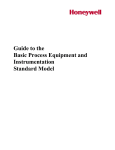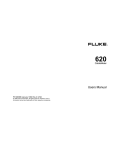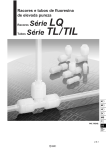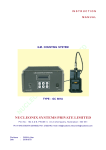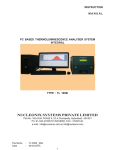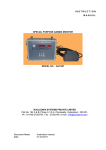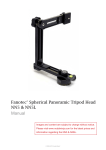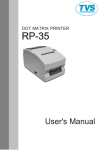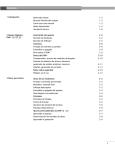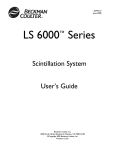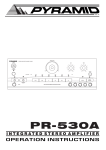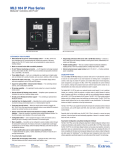Download product manual
Transcript
INSTRUCTION MANUAL LIQUID SCINTILLATION COUNTING SYSTEM WITH 8K MCA (USB) ALONG WITH PC S M E T S Y S T V P D T L X I N O E L C U NUCLEONIX SYSTEMS PRIVATE LIMITED N TYPE : LS620 Plot No : 162 A & B, PHASE II, I.D.A.Cherlapally, Hyderabad - 500 051 Ph: 91-040-27263701, 32918055, 32914548 FAX : 27262146, e-mail : info@nucleonix.net (or) info@nucleonix.com, Website : www.nucleonix.com File Name : Date : LS620_Man 20-08-2013 Contents Description Pg.No. T V P CHAPTER I Introduction CHAPTER II Specifications CHAPTER III Block diagram & System Description CHAPTER IV Operating Procedure S M E T S Y S D T L 01-08 09-10 11-13 4.1. System Interconnections 14-14 4.2. Operating Instructions 15-21 X I N O E L C U N CHAPTER – I 1. INTRODUCTION ON LIQUID SCINTILLATION & THEORY Liquid scintillation counting (LSC)is an analytical technique,which measures activity of radionuclide from the rate of light photons emitted by a radioactive sample dissolved in a liquid scintillator. It is a powerful technique especially for detection and quantification of low energy radionuclides as it enjoys advantage of 100% source detector geometry. The manual provides the user the operating procedure and system details of the PC based manual liquid scintillation counting system with USB interface developed in BARC .The liquid scintillation counting system presented here is designed using advanced technology. It is a computer controlled manually operated system for detecting even small amount of beta and alpha radioactivity. It has wide range applications in biology, Medicine and Environmental studies. The system has been fabricated for the quantitative estimation of beta emitters like,h3,c14 and p32 .Usage of excellent quality high efficiency matched pair of photomultiplier tubes, precision fast and slow chamber with preamplifiers,USB based spectroscopy quality MCA , rugged manually operated sample chamber with lead shield allow the system to offer high efficiency even for low energy beta emitters such as tritium and also a very low background w ith ability to count radioactivity in bulk quantify of samples one by one. The instrument is highly reliable and incorporates several built in features such as coincidence correction for low background. The USB bus interface of the MCA provides an excellent connectivity with most of the new PCs and laptop computers. The LSC application software provided, integrates with the hardware providing online display of spectrum build up and measure of the activity of the sample. X I N O E L C U N S M E T S Y S T V P D T L 1.1 WHY LIQUID SCINTILLATION? Most of the detectors used to measure ionizing radiation (such as alpha,beta,and gamma radiation )are based on the ability of the radiation to ionize materials or to excite atoms within materials. When excitation is followed by fluorescent de excitation the light emitted can be converted into electric current by light sensitive devices e.g. PMTs scintillation detectors are based on light emission. A small current is generated when production of charge carriers (i/e ions electrons and holes )takes place between the charged electrodes of detector. Detectors based on production of charge carriers are either gas filled ionization chamber,proportional counters and GM counters in which charge carriers are produced by ionization of a gas of solid usually semiconductor crystals. In latter case electrons and holes are produced in pairs. 1 Gas detectors use a defined gas cavity surrounded by wall whose inner surface is electrically conducting and acts as one electrode and a second electrode (sometimes a central wire or rod),which penetrates the gas volume and is electrically insulated from the conducting wall.There is a voltage applied between the two electrodes. When ionizing radiation enters a gas- filled detector it may interact directly in the gas and knock charged particles,such as electrons,from the wall;these electron may enter the gas and also cause ionization. When ionization of the gas occurs, the positive and negative ions are attracted towards the negative and positive electrodes,respectively. Gas detectors can respond to alpha,and gamma radiation . In order to detect alpha and beta radiation the detector must be equipped with a sufficiently thin window to allow these radiations to enter the gas. Alpha particles travel very short distance in materials (often less than 100 micrometers in solid low- atomic – number materials ) so the window must be quite thin,usually about 1/3 the thickness of a standard sheet of paper. T V P D T L Scintillation detectors on the other hand respond to energy absorption from ionizing radiation by emitting light. The light is most often measured with a photo multiplier tube that converts the light to an electronic pulse. These detectors may be either inorganic crystals or organic compounds . All inorganic scintillators rely on the crystalline nature of the material for light production and most have impurity atoms,with ionization potentials less than atoms of the crystal, added as activators. Ionizing radiation may elevate electrons can migrate in the conduction band and band to it valence band may also move and ionizes host atom that it encounters. The impurity ions introduce trapping levels in the energy gap between the valance and conduction bands. In brief,electrons may move into an excited level of the activator ion and then drop to the ground energy state with the emission of light. Inorganic crystalline scintillators, especially sodium iodide activated with thallium,NI (Tl),have been mainly used for gamma-ray detection because of their high atomic number and thus a high photoelectric cross section for gamma-rays. X I N O E L C U N S M E T S Y S Scintillation detectors for beta radiation are often organic scintillators. Organic scintillators operate at the molecular level, which means that the light emission occurs as a result of fluorescence as a molecule relaxes from an excited level following excitation by energy absorption from ionizing radiation . Molecules such as anthracene, trans-stilbene, paraterphenyl,j and phenyl oxazole dervatives are among the many organic species that have useful scintillation properties. Such organic molecules dissolved in organic solvents are used as liquid scintillators. A classic application is in the measurement of low-energy beta radiation (e.g., from tritium,c14,). In such cases the sample containing the radioactive beta emitter is dissolved in, or in some cases suspended in, the liquid scintillation solution . 2 The emitted beta radiation transfers energy through the solvent to the scintillator molecule,which then emits light that is detested by photomultiplier tubes . Liquid scintillators can also be used for alpha particle measurements energy measurements. The key difference is that in LSC the scintillation takes place in a solution of scintillator, rather than in a solid crystal . This allows close contact between the isotope atoms and the scintillator, which is not possible with solid scintillation . With LSC the short path length of soft beta emission is not an obstacle to obstruction. Thus though beta spectroscopy is possible with gas detector and solid state detectors also but the advantage of 100% source detector geometry in the case of liquid scintillator makes it the ideal detector choice especially for low energy beta emitters like tritium . Also organic scintillators essentially contain carbon,hydrogen i.e low atomic number elements resulting in less back scattering for beta radiations. All this goes to make liquid scintillation detectors and ideal choice for beta as well as alpha emitters. T V P D T L 1.2 THEORY OF LIQUID SCINTILLATION Liquid scintillation counting is an analytical technique, which measures activity of radionuclides from the rate of light photons emitted by a liquid sample. In this technique the radioactive material (such as h3 , c14) is dissolved in liquid scintillation system consisting of a solvent (such as toluene ) and a scintillating solute (such as PPO) contained in a glass or plastic vial. The radiations emitted by the radioactive sample transfer energy to solvent molecules,which get excited and transfer their energy to solute molecules, which on deexcitation emit photons. Some times a secondary solute is used to match the wavelength of light emitted to that of PMT characteristics. The number of photons emitted is proportional to energy of radiation and is detected using photo multiplier tubes and associated electronic circuits. X I N O E L C U N S M E T S Y S LIQUID SCINTILLATION PRINCIPLES β β Radioactive materials Excited Solvent Molecules Fluor Molecule Beta Particle PMT Analyzer .. ..... .. The above figure provides a graphic illustration of the way the emitted radiation interacts with the cocktail (a mixture of a solvent and a solute ) leading to a count being recorded by the system. The detailed stepwise procedure that results in emission of photons is given below. 3 a) b) c) d) e) f) Beta particle is emitted in a radioactive decay . To assured efficient transfer of energy of its kinetic energy between the beta particle and the solution , the solution is a solvent for the sample material. In the relatively dense liquid, the beta particle travels only short distances before all of its kinetic energy is dissipated. Typically a beta particle will take only a few nanoseconds to dissipated all its kinetic energy. The energy is absorbed by the medium in 3 forms: heat, ionization and excitation. Some of the beta energy is absorbed by solvent molecules making them excited (not ionized). Energy of the excited solvent is emitted as UV light and the solvent molecule returns to ground state. The excited solvent molecules can transfer energy to each other and to the solute . An excited solvent molecule,which passes its energy to a solute molecule,disturbs the orbital electron cloud of the solute raising it to a state of excitation. As the excited orbital electrons of the solute molecule return to the ground state, photon is emitted. If photon is of UV light, an additional wavelength shifter is added which absorbs the UV photon and emits blue light flashes upon return to ground state. Nuclear decay events produce approximately 10 photons per keV of energy. The energy is dissipated in a period of time on the order of 5 nanoseconds. The total number of photons from the excited solute molecules constitutes the scintillation. The intensity of the light is proportional to the beta particle’s initial energy. Blue light flashes hit the photo cathode of the photo multiplier tube (PMT). Electrons (proportional to the blue light pulses) are ejected producing an electrical pulses that is proportional to the number of blue light photons. A LSC normally has two PMT’s the amplitude of the PMT pulse depends on the location of the event within the vial . An event producing 100 photons will be represented be a larger pulse if the event is closer to the PMT than if the event is more remote . The signal from each PMT is fed into a circuit which produces an output only if the 2 signals occur together, that is within the resolving time of the circuit, approximately 20 nanoseconds(coincidence circuit ). By summing the amplitude of the pulses from each PMT, an output is obtained which is proportional to the total intensity of the scintillation. This analog pulse rises to its maximum amplitude and falls to zero. The amplitude of the electrical pulse is converted into a digital value, which represents the beta particle energy, passes into the analyzer where it is compared to digital value for each of the L SC’s channels. Each channel is the address of a memory slot in a multichannel analyzer which consists of many storage slots or channels concentrating the energy range from 0-1000keV . In this manner, the sample is analyzed and the spectrum can be plotted to provide information about the amount of radioactive material dissolved in the cocktail. The windows based software provides on -line display of energy spectrum, total counts and elapsed time of the sample along with set parameters display. X I N O E L C U N S M E T S Y S 4 T V P D T L 1.3 FACTORS AFFECTING LIQUID SCINTILLATION COUNTING: Following interferences are inherent to liquid scintillation process: 1.3.1 QUENCHING The counting efficiency of the solute solvent system is affected by many different factors which reduce detection efficiency. Some of the important processes are: i) CHEMICAL QUENCHING: Sosmetimes called impurity quenching causes energy losses in transfer from solvent to solute. ii) COLOR QUENCHING : Energy losses occur when solution is colored, since photons when they pass through a colored solution their wavelength may be altered to a value where PMT response is reduced. T V P D T L 1.3.2 CHEMICAL LUMINESCENCE/PHOTO LUMINESCENCE: Chemical luminescence is production of light as a result of chemical reaction. This most typically occurs in samples of alkaline pH and /or those containing peroxide, when mixed with emulsifier-type scintillation cocktails. Photo luminescence results in the activation of cocktail and /or vial by ultraviolet light or cosmic rays in lab environment. Dark adaptation of one to two hour helps to decay all this photo luminescence . S M E T S Y S 1.3.3 ELECTROSTATIC DISCHARGE: Electrostatic discharge is a photon producing interference in liquid scintillation counting. Separation of two non conductive materials can generate significant amount of static electricity. Static charges can develop in the scintillation vial or in scintillation cocktail, the resulting discharge will produce light, which will be detected by a liquid scintillation counter. X I N O E L C U N 1.3.4 BACKGROUND: For low level counting the lowest activity that can be measured is a function of background. The factors causing background in a typical LSC system are: a) Instrument background:Results from the noise (Dark noise, after pulse noise) of the PMT’s b) Cross talk: A scintillation event initiating photon within one PMT will be seen by the other PMT c) Vial glass and PMT face:Background scintillation in the vial wall and the PMT face are generated by the effects of cosmic or environmental radiation’s of glass walls and PMT face (k40 radiation is present in glass wall and PMT face.) d) Scintillator: Scintillator background pulses are also caused by cosmic and environmental radiation. 5 The first type of background is almost eliminated by using low nose matched pair of PMT’s and by using a fast resolving circuitry. The signal from each PMT is fed into a circuit, which produces an output only of the two signals arrive within a resolving time of 10-20 ns. Vial glass containing a low k40 content should be chosen. Lead shielding is used to reduce effect of cosmic radiations. All these factors result in a background of 12-15 cpm in tritium window. 1.4.1 QUENCHING AND EFFICIENCY : Quenching affects efficiency of conversion process beta particle energy to photo electron. Therefore measured counts are only representative for the radio activity of the sample if they are corrected for this quenching effect. All forms of quenching have the effect of reducing the number of photons per keV of beta particle energy which reach the PMTs. Because photons interact with PMT’s , the pulse amplitude is reduced for the same energy particle. This result is a shift to lower amplitudes of the pulse height spectrum. For rsdionuclides with high energy beta particles this shift may have little or no effect on counting efficiency but with lower energy radionuclides the effect can be considerable. Tritium particularly is affected by quenching. Because beta particle energy is co low that relatively few photons are produced event with no quenching. With quenching a particle of higher energy will be required to produce same number of photons. Events below coincidence threshold are lost. Thus the collective effect of quench is a reduction in the number of photons produced and, therefore, detected CPM( counts per minute). Counting efficiency is affected by the degree is quenching in the sample. To determine absolute sample activity in DPM (disintegration per minute or absolute activity), it is necessary to measure the level of quench of the samples first, and then make the corrections for the measured reduction in counting efficiency. X I N O E L C U N S M E T S Y S T V P D T L Counting efficiency= CPM/DPM 1.4.2 MEASUREMENT OF QUENCH: It is possible to measure quench accurately via high- resolution spectral analysis. Quenching manifests itself by a shifting of the energy spectrum toward lower energy channels in the multichannel analyzer(MCA) To determine efficiency various methods as SCR (sample channel ratio), SIS( spectral index of sample ) are used. The SIS value decreases as quench increases, reflecting the shift of the spectrum to lower energy . each of these techniques involves measuring a set of quenched standards all with the same activity but with different levels of quench. So from the count rate obtained and efficiency calculated activity can be obtained. 6 SIS = K u Σ X * n(x) x=0 u Σ n(x) x=0 where : x is the channel number, u is the end channel n(x) is the counts at channel x and K is a constant factor 1.4.3 QUENCH CURVE A quench curve standard curve is a series of standards in which the absolute radioactivity (DPM) per vial is constant and the amount of quench increases from vial to vial. A quench curve uses the relation ship between counting efficiency and QIP (quench indicating parameter ) (SCR&SIS are QIP) to correct the measured CPM to DPM . When a quench curve is made, the DPM value in each standard is known. Each standard is counted and the CPM is measured . The counting efficiency is calculated using the following relationship. Counting efficiency= CPM/DPM S M E T S Y S T V P D T L At the same time, QIP is measured for each standard. A correlation is made using the QIP on one axis (X) and the % efficiency on the other axis (Y). A curve is fitted to the standard points. Once the quench curve is stored in the instrument computer, it can be used for automatic DPM calculations. When unknowns are counted, the sample CPM and the QIP are measured . Using the QIP , the counting efficiency is determined from the quench curve. Sample DPM are then calculated by applying the appropriate efficiency to the CPM of the sample. X I N O E L C U N 7 Efficiency SIS Efficiency correlation based on SIS S M E T S Y S T V P D T L Quenched spectrum dN/dE X I N O E L C U N Unquenched spectrum Channel number Effect of quenching on the accumulated spectrum 8 CHAPTER - II SPECIFICATIONS Detector : Cocktail consisting of radioactivity dissolved in liquid scintillator contained in glass or plastic vial viewed by matched pair of photo multiplier tube. PMT 9829 QA Specifications of PMT 9829 QA : Two matched PMT power of E.T. make Effective cathode size : 45mm Dynodes : 12LFCsSb Quantum efficiency : 30% Gain : 6*106 Dark current : 1 nano amp (typ) Dark counts : 200cps (typ) V(k-a) : 2800V (max) I (a) : 200 micro amp (max) S M E T S Y S T V P D T L Slow preamplifier(s) : One for each PMT are built-in. These two outputs are summed & fed to MCA. Fast pre-amplifier(s) : One for each PMT are built-in to check for time co-incidence output to achieve low Background. Housing X I N O E L C U N Sample handling : Manually operated light sample chamber shielded with lead. : Using 20ml vials. High Voltage Unit HV502 (TWO) : Two independently controllable HV are built-in with (0-2000) KV@0.5mA ripple & noise < 20mV. Signal Proessing Unit SP560 : This is a two bit module, which received signals from slow/ fast pre-amplifier of each of the PMTs and processes the signal. This essentially has coincidence circuit, summing amplifier and shaping circuits. Output of this is fed to MCA card. Output : Live display of acquisition of beta spectrum 9 Specifications of USB-MCA : MCA resolution Spectrum memory Max counts / channel Pulse processing time Pile up rejection DNL INL MCA Input Timer Preset Time LLD, ULD, Baseline Power requirement : : : : : : : : : : : : 256, 512, 1K, 2K, 4K and 8K channels 128 K bytes single port SRAM 31 bit (2 Giga counts) 7 ms including ADC conversion time of 5 ms Active high TTL input from spectroscopy amplifier Better than + 1% Better than + 0.05% F.S Single channel, 0 to +10 volts 32 bit, integrated in FPGA LIVE or CLOCK, 1 sec to 136yrs Digitally set through software 5V, ~ 500 mA through USB cable directly (No external power supply required) S M E T S Y S T V P D T L Additional accessories required : Personal Computer sytems : (i) Unquenched standards 3 a. H 264200 DPM (typical) 14 b. C 132400 DPM (typical) c. Background (ii) 20ml. sample vials for sample analysis X I N O E L C U N Efficiency : (a) For tritium (3H) (in toluene based scintillating solution) > 50% with background less than 40 cpm (b) For carbon (14C) (in toluene based scintillating solution) > 90% with background less than 70 cpm Operating environment : Air conditioned (20-25o) dust free environment. Power System operates on 230V, 50Hz, AC supply High voltage : Auto set or user adjustable up to 1800V : 10 CHAPTER - III BLOCK DIAGRAM & SYSTEM DESCRIPTION The manual Liquid Scintillation Counting System with USB interface consists of following subsystems : Sample chamber unit containing detector assembly having matched pair of photo multiplier tubes with socket and pre-amplifiers. This system consists of the following constituent unit a. MINIM bin power supply (MB403), b. High voltage modules (HV502 two numbers) c. Signal Process unit (SP560), d. USB MCA module e. Sample chamber containing PMT’s with Lead shielding, f. Personal Computer System g. Unquenched standards (14C, 3H & Background) h. Necessary inter connecting cables The block diagram given below indicate inter connection between various sub-systems S M E T S Y S High Voltage Unit_1 HV502 (0-2000V) X I N O E L C U N Slow Pre-amplifier 1 High Voltage Unit_2 HV502_2 Sample (0-2000V) Bottle PMT 1 Fast Pre-amplifier 1 T V P PMT 2 D T L Sample chamber with lead shield enclosure Slow Pre-amplifier 2 Fast Pre-amplifier 2 Coincidence ckt Shaping ckt USB MCA PC Summing Amp Signal processing unit (SP560) LV (+12V) LSC signal processing card BIN & Power supply (MB403) Low Voltages for Pre-amplfiers & High voltage units Gating coincidence output 11 LV (+12V) The block diagram of manual PC based liquid scintillation counting system is shown above. The system consists of a sample chamber that encloses a matched pair of photo multiplier tubes. The photo multiplier tubes are mounted axially and view the scintillating solution contained in a glass or plastic vial. The vial consists of the radioactive sample dissolved in the liquid scintillation solution. The radiations emitted by the radioactive sample transfer energy to solvent molecules, which get excited and transfer their energy to solute molecules, which on de-excitation emit photons. Some times a secondary solute is used to match the wavelength of light emitted to that of PMT characteristics. The light is emitted in duration of few nano seconds, as organic scintillators are fast scintillators. The number of photons emitted is proportional to energy of radiation and is detected by the two photo multiplier tubes. The response of the photomultiplier tube to the photons incident on it is a current that flows for a time equal to charge collection time as shown below. The time integral over the duration of the current is Q or the total amount of charge generated in that specific interaction. I(t) S M E T S Y S T V P D T L Time t Pre-amplifiers mounted along with photo multiplier tubes process the electrical pulses representing radioactive decay event from both the photo multiplier tubes. The nature of the signal pulse produced from a single event depends on the input characteristics of pre-amplifier to which the detector is connected. The equivalent circuit can be represented as below. X I N O E L C U N C Detector R V Here R represents input resistance of pre-amplifier and C represents equivalent capacitance of detector, cable used to connect detector and input capacitance of pre-amplifier itself. If time constant RC is kept very small in comparison to charge collection time then current flowing through load resistance R is essentially equal to the instantaneous value of the current flowing in detector. The signal voltage V under these conditions has a shape nearly identical to the time dependence of the current produced within the detector. This is case with fast pre-amplifier connected to photomultiplier in LSC system. The input resistance R is kept 50 ohms. Fast pre-amplifier processes the current pulse from anode of photomultiplier. The fast pre-amplifier output is negative analog voltage pulse of duration approximately 20 nano secs. The signal pulse has a shape nearly identical to the time dependence of the current produced within the detector. 12 If RC time constant is kept larger than detector charge collection time then detector current is momentarily integrated on capacitance. The amplitude of signal pulse in this case is directly proportional to the corresponding charge generated within detector. This is case with slow pre-amplifier connected to photomultiplier in LSC system. R in this case is kept in mega ohms, Thus output of slow pre-amplifier is proportional to the integrated charge in detector. The amplitude of pulse of slow pre-amplifier output is thus proportional to charge generated within detector or in other words proportional to energy of incident radiation. Also a measurement of the rate at which such pulses occur will give the corresponding rate of radiation interactions within detector. D T L Thus fast and slow pre-amplifiers mounted along with photo multiplier tubes process the electrical pulses representing radioactive decay event from both the photo multiplier tubes. The fast pre-amplifier as outlined above provides at its output a signal pulse that has a shape nearly identical to the time dependence of the current produced within the detector (it is a fast linear pulse of short duration approx 20 nano secs). The slow pre-amplifier as outlined above provides at its output a pulse whose amplitude is proportional to energy deposited in detector. S M E T S Y S T V P The signals from the two fast pre-amplifiers are fed to LSC signal processing card. The LSC signal processing card contains a coincidence circuit. This circuit produces an output only if the two signals from the two fast pre-amplifier output occur together, that is within the resolving time of the circuit, approximately 20 nano secs. Thus output of coincidence circuit on LSC signal processing card is a TTL pulse that appears only when the pulses from the two fast pre-amplifiers arrive together. Noise pulses being random pulses thus do not result in a TTL pulse being generated. This results in very low background. The signals from the two slow pre-amplifiers are also fed to LSC signal processing card. The summation circuit present on LSC signal processing card is essentially a gated summation circuit. It sums only those pulses from the two slow pre-amplifiers that arrive in coincidence. (Essentially the ON / OFF of gate is controlled by TTL logic output of coincidence circuit). The coincident summed pulses are shaped by shaping circuit and fed to USB MCA card. In the MCA the amplitude of the pulse is converted into a digital value, which represents the beta particle energy. X I N O E L C U N In this manner, the sample is analyzed and the spectrum can be plotted to provide information about the amount of radioactive material dissolved in the cocktail. The windows based software provides online display of energy spectrum, total counts and elapsed time of the sample along with set parameters display. The complete electronics i.e. high voltage required for photo multiplier tubes, low voltage, LSC signal processing card and USB based MCA are contained in a single mains (230V) operated compact portable module. 13 CHAPTER - IV INSTALLATION & OPERATING INSTRUCTIONS Background X I N O E L C U N S M E T S Y S T V P D T L (3C) 264200 DPM (14C) 132400 DPM Empty vial Unquenched standards 4.1 SYSTEM INTER CONNECTIONS : S.No Name of the c able From To 1. MHV to M HV co nnecto r ca ble s (2 no’s) Hig h volt age m od ule -1 Hig h volt age m od ule -2 HV1 of PMT1 (lef t side) B le ede r 1 (PM T) HV2 of PMT2 (right side) B le eder 2 (PMT ) 2. BNC to B NC conn ector ca ble s (5 no’s) Fast Pre-am plifier -1 Slow P re -am plifie r 1 Fast Pre-am plifier-2 Slow P re -am plifie r-2 MC10 00U mod ule F-IN1 F1 o f S P56 0 S-IN1 S o f S P56 0 F-IN2 F2 o f S P56 0 S-IN2 S2 of S P5 60 MCA m odule U SB of S P5 60 3. 9 pin D-t ype fem ale co nnector t o 5 p in I/O fem ale MB 403 (B in rear sid e) MB 403 (B in rear sid e) Pre-am plifier -1 Pre-am plifier-2 14 4.2. INSTALLATION PROCEDURE : ● Unpack liquid scintillation counting system and place all the subsystems on the table. The unpacked subsystems include the following units. (a) Minim Bin, (b) HV Module (c) Signal Processing Unit, (d) USB MCA module, (e) Personnel Computer System with printer, (f) Sample chamber with lead shielding, (g) Matched Photo multiplier tubes (PMT) (i) All interconnecting cables etc. ● Place the sample chamber with lead shielding arrangement in the middle of the table. Demount cylindrical PMT housing shells and arrange to install the PMTs into this. Ensure to open the PMTs from their packing in darkness. ● D T L After installing them into cylindrical shell, close the sample chamber housing properly to eliminate light leakage. Arrange bin with all these above modules plugged-in, along with PC and printer as shown in the pi ctures on the front page of this user manual. Make all the interconnection between various modules and sample chamber assembly as per the details given in the interconnection table, under 4.1. S M E T S Y S T V P ● Switch on the power to the instrument. Slowly increase the HV bias. In the 2 HV modules (HV502) increase adj. dial till operating voltage, as specified for the PMTs, has reached. (PMT manufacturer’s data has been taken into account) Important Note : After loading of the PMT it may be good to leave the system overnight before using the system. Next day only system can be powered-up for use. ● To ascertain that the PMT housing and sample chamber has no light leakages, leave the system for about 2 hours for background acquisition in PHA mode. User is requested to ensure that the following unquenched standard and vials are kept ready for data acquisition and standardization. ● Now invoke MCA software and select PHA mode with 1K MCA channel (refer to MCA user manual if required). Now acquire the BG for 60 secs and they should not be any counts recorded without any vial (BG/Standard) But it has been noticed that for 3H window (85-115) channel window counts recorded were found to be 3 in 60 sec. for 14C window This indicates that there no light leakages. ● X I N O E L C U N 15 Standards : It is assured that the following standards are procured & are available for system calibration & installation Pekin Elmer Unquenched stadards (15ml) Assay date : Aug 27, 2009 Expiration date : Aug 27, 2014 BG standard H3 (Tritium) = 0.2µCi 262900 C14 (Carbon-14) = 0.1µCi 126700 DPM T V P D T L Next load Tritium (H-3) standard. Acquire PHA spectrum for about 60 sec. Now calculate from this DPM and efficiency should be more or equal to 40%. Screen dump of H3 (Tritum) PHA spectrum is shown in fig. (3) Next replace BG standard and acquire the BG for 60 sec or 3 minutes. And compute BG, but is has been that for 3H window (85-115) ----------------- 58 cpm. It should be less than or equal 45 to 50%. in the (tritum) 3H RoI S M E T S Y S Substract the BG from standards. 14C & 3H Efficiency calculation for (14C): CPM x 100 DPM = 123251 x 100 132400 = 93.08% X I N O E L C U N Efficiency calculation for (3H): CPM x 100 DPM = 117558 x 100 264200 = 44.8% Screen dump of BG for H3 PHA spectrum fig.(1) Next replace Carbon (C-14) standard and count for 60 sec, calculate DPM and efficiency, it should be equal or more that 90%. Replace it with BG standard & count for BG for 60 sec with the same LLD & ULD settings. Screen dump of C14 (carbon-14) PHA spectrum with standard fig.(4) Calculate DPS & BG it should be less than 65 to 70%. Screen dump of B.G for C14 fig.(2) in the (Carbon-14) 14C RoI, 90cpm. Illustration of loading & unloading of standard(s) vails into PMT - sample chamber assembly : Fig. no. 5,6,7,10 & 11 clearly illustrates loading / unloading of vails into the chamber for counting purposes. 16 S M E T S Y S Fig (1) : B.G for H3 (PHA spectrum) X I N O E L C U N Fig (2) : B.G for C14 17 T V P D T L S M E T S Y S T V P Fig(3) : H3 (Tritium) PHA spectrum (60-110) channels) X I N O E L C U N Fig (4) : C14 (Carbon-14) PHA spectrum with standardw 18 D T L T V P D T L Fig.5 : Liquid scintillation System PMT housing & sample chamber. Lever in ‘UP’ position faciliates loading (place or remove) of ‘Vial’ S M E T S Y S Once lever is rotated up then rotate vial chamber lid, in clockwise direction, and open the cap, now vial, can either be placed or removed. < X I N O E L C U N < Rotate Vial holder in anti clock direction. Remove cap to load vial either H3 or C14 standard for counting. Fig. 6 Now rotate vial holder in clock wise complete as indicated & slowly lower handle lever to position the vial for counting position. > Fig. 7 19 T V P D T L Fig. 9 : Right side PMT connections Fig. 8 : Left side PMT connections S M E T S Y S Lever ‘Down’ position vial counting > X I N O E L C U N Fig. 10 Cap total clockwise position, facilitates < Lever ‘Up’ position to load vial > Fig. 11 20 D T L < Fig.13 T V P Signal processing unit (SP560) < Fig.12 X I N O E L C U N S M E T S Y S Fig.14 : USB - MCA module (MC1000U) 21

























